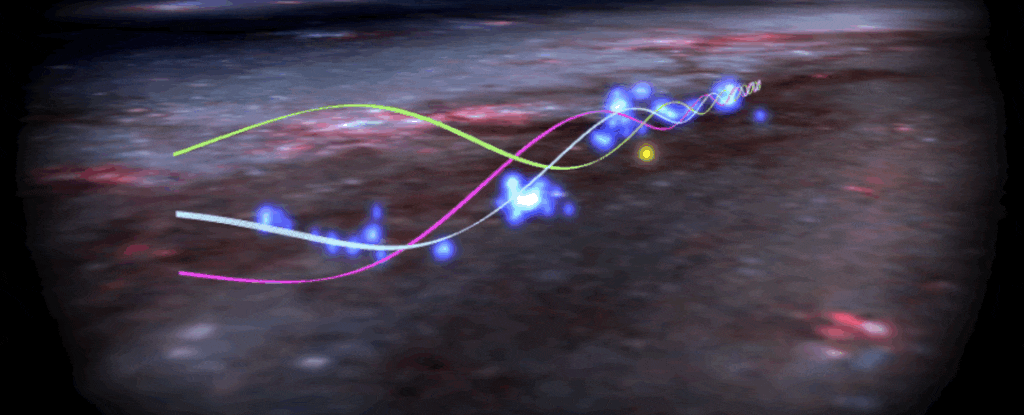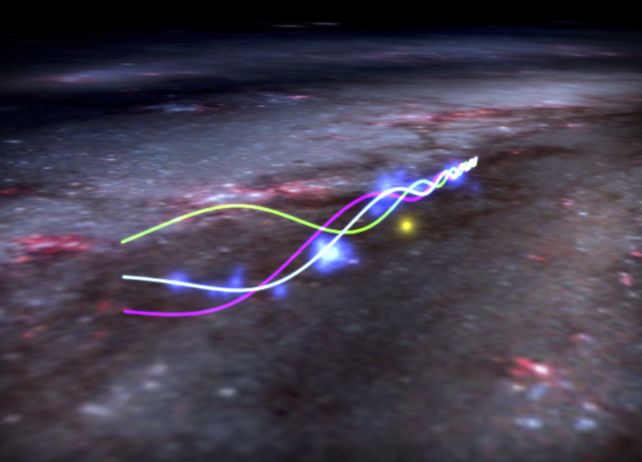ARTICLE AD
 An animation showing the motion of the Radcliffe Wave. The yellow dot represents the Sun. (Ralf Konietzka, Alyssa Goodman, and WorldWide Telescope)
An animation showing the motion of the Radcliffe Wave. The yellow dot represents the Sun. (Ralf Konietzka, Alyssa Goodman, and WorldWide Telescope)
Gazing out upon the apparently unchanging sea of stars around us, it's tempting to think of the Milky Way galaxy as static and everything within it as fixed and immutable.
While the timescales on which our galaxy moves often defies human experience, move it does indeed.
Not all of these dynamic processes are easy to see. Just a few years ago, scientists discovered a huge, wave-shaped structure extending some 9,000 light-years in length snaking along a spiral arm of the Milky Way, just 500 light-years from the Solar System at its closest point.
Named the Radcliffe Wave, this squiggle of star-forming gas is in itself a remarkable discovery, and there's a lot we still don't know about it. But a team of scientists led by astrophysicist Ralf Konietzka of Harvard University has just learned one thing: like many objects in the Milky Way, the Radcliffe Wave is in motion.
And not just an orbital motion around the galactic center. The Radcliffe Wave is oscillating as a periodic traveling wave.
"By using the motion of baby stars born in the gaseous clouds along the Radcliffe Wave," Konietzka explains, "we can trace the motion of their natal gas to show that the Radcliffe Wave is actually waving."
Our understanding of the three-dimensional properties of the Milky Way has improved dramatically in recent years, largely thanks to a project known as Gaia.
Gaia is a spacecraft that shares Earth's orbit around the Sun, and has been carefully mapping the Milky Way for several years. It uses parallax to measure with high precision the positions of the stars in three dimensions. But that's not all – it also measures properties such as their proper motion and velocity.
 A diagram illustrating the Radcliffe Wave. The white line represents its current position, with blue blobs representing star clusters. The green and purple lines indicate future positions. The yellow dot is the Sun. (Ralf Konietzka, Alyssa Goodman, and WorldWide Telescope)
A diagram illustrating the Radcliffe Wave. The white line represents its current position, with blue blobs representing star clusters. The green and purple lines indicate future positions. The yellow dot is the Sun. (Ralf Konietzka, Alyssa Goodman, and WorldWide Telescope)This means we now have the most accurate map of the Milky Way to date, including the positions of stars, their direction of travel, and how fast they are moving. Scientists used this data to discover the Radcliffe Wave back in 2018, publishing their findings in 2020 after putting together a 3D map of the structure.
There wasn't enough information at the time to understand the structure in greater detail, but a subsequent release of additional Gaia data has provided vital information. With this, the researchers were able to assign positions and motions to clusters of baby stars embedded in the star-forming material that makes up the Radcliffe Wave.
Extrapolating from this information, the researchers found that the structure is, indeed, undulating, like a giant cosmic serpent winding through the Milky Way. The team's calculations reveal that this motion can be influenced by the gravity produced by normal matter in the galaxy; we don't need to start mapping out dark matter to explain it.
The team's measurements even suggest that the supernovae that virtually cleared the bubble of space in which the Milky Way resides was born in a cluster of stars within the Radcliffe Wave.
But, naturally, there are far more questions to be answered. Why did the wave form? And why is it moving like it does? And how many of them are out there – is the Milky Way interwoven with sinusoidal arrangements of undulating gas that are yet to be discovered?
"The question is, what caused the displacement giving rise to the waving we see?" says astronomer Alyssa Goodman of Harvard University. "And does it happen all over the galaxy? In all galaxies? Does it happen occasionally? Does it happen all the time?"
Theories, the researchers say, range from supernova explosions, to gravitational interactions with satellite galaxies, and encounters with other large galaxies.
We know that the Milky Way has joined with multiple other galaxies in the past, and that it appears to be currently undergoing another collision. Research last year found that dark matter can have a pretty dramatic effect on the overall structure of the galaxy. There are many factors that could be at play.
"Upcoming deep and wide surveys of stars, dust and gas will likely uncover more wave-like structures," the researchers write, "and measurements of their motions should provide insights into the star formation histories and gravitational potentials of galaxies."
The team's findings have been published in Nature.

 1 year ago
64
1 year ago
64 

